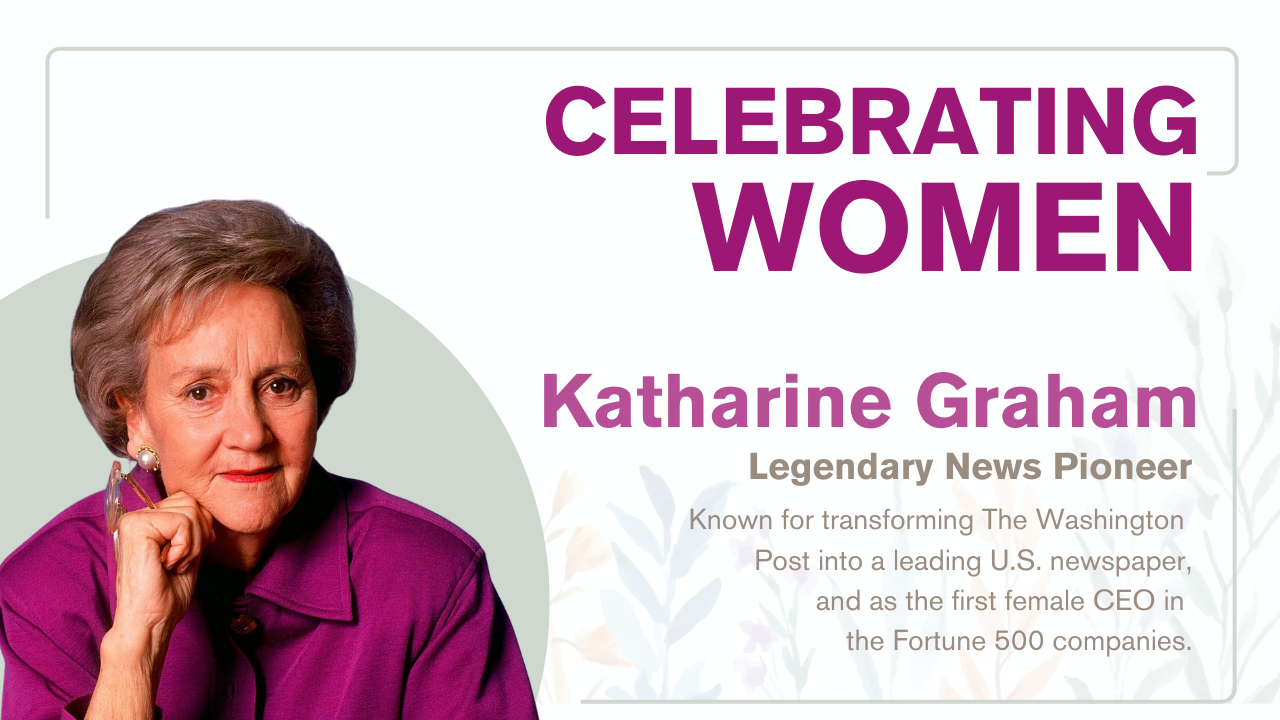
Katharine Graham: The Trailblazing Publisher Who Transformed American Journalism
Mar 05, 2025Katharine “Kay” Meyer Graham may be a name you recognize, or perhaps you already know what makes her one of the most influential women in history. But what you may not realize is how much she was just like the rest of us.
Though Kay was born into privilege, she faced the same emotions and struggles that so many of us do—doubt, self-sabotage, regret, and joy. Her life was filled with challenges, disappointments, and bold decisions that ultimately opened doors for countless women who followed in her footsteps. But if you had asked her, she likely wouldn’t have seen herself as a trailblazer or a Joan of Arc figure. Instead, she would have said she was simply walking alongside other women, arm in arm, pushing forward together.
Kay was born on June 16, 1917, to multimillionaire financier Eugene Meyer. Raised to be a quiet and well-mannered young lady, she was taught to speak only when spoken to—and even then, to ensure her words were ladylike.
In 1934, she was accepted to Vassar College but later transferred to the University of Chicago, where she graduated in 1938. After college, she pursued a career in journalism, working as a reporter for the San Francisco News from 1938 to 1939. She later joined The Washington Post, contributing to the editorial staff and The Sunday Post. Journalism and business were in her blood, and from the start, she showed a hands-on, roll-up-your-sleeves attitude—qualities that would shape her as a leader.
In 1940, Kay married Philip Graham, a lawyer who became editor of The Washington Post in 1946. When Philip took control of the paper, Kay stepped back as expected, dedicating herself to raising their family.
But in 1963, tragedy struck. Philip died by suicide, and at 46, Kay found herself thrust into leadership. She became President of The Washington Post—a role no one had prepared her for. In 1969, she took over as Publisher, making history as one of the first female publishers of a major U.S. news outlet. More significantly, she became the first female CEO of a Fortune 500 company—a title she held alone until 1998, when Marilyn Carlson Nelson took the reins at Carlson Travel.
 Image grabbed from townandcountrymag.com
Image grabbed from townandcountrymag.com
Kay Graham didn’t just run The Washington Post—she transformed it. She had an unwavering commitment to journalistic integrity, backing groundbreaking stories like the Pentagon Papers and Watergate, even when the stakes were high. Under her leadership, The Washington Post became one of the most respected newspapers in the world, and its success soared—exceeding $1 billion in growth.
On the surface, she appeared composed, confident, and formidable—everything women of her time aspired to be. But those who knew her well saw the struggles beneath. She wrestled with insecurity, feared failure, and was often influenced by powerful men in her orbit. Yet, despite her doubts, she remained a fierce advocate for women.
Political columnist Maralee Schwartz recalled a moment in 1984 when she, like many women, doubted her own abilities. Kay’s words left a lasting impact:
"We’re our own worst enemies. We grew up thinking that only men could do the big, important jobs. We always worry that we're not good enough. Do you think there is even one man out there who is worrying about what he just wrote? Not one. We're our own hardest critics."
In 1998, Graham won a Pulitzer Prize for her memoir, in which she candidly reflected on her life—from being the obedient daughter to becoming what she once saw as a "doormat wife." She even revealed a long-rumored affair with Warren Buffett in 1973, openly sharing how Buffett’s wife, Suzie, had given her blessing for their relationship.
Beyond journalism, Graham was a philanthropist, quietly funding causes she believed in—one of them being the seed money for Ms. Magazine. She believed in lifting others up without seeking recognition, staying true to the reserved demeanor she was raised with.
Today, only 10.5% of Fortune 500 CEOs are women. That number may seem small, but without trailblazers like Katharine Graham, where would we be? She didn’t just break barriers—she made sure others had the chance to walk through the doors she opened.
To learn more about her remarkable story, check out the resources below. We have an obligation to pave the way for those who come after us—just like Kay did.
References and Resources:
🔗 Katharine Graham | The Washington Post
